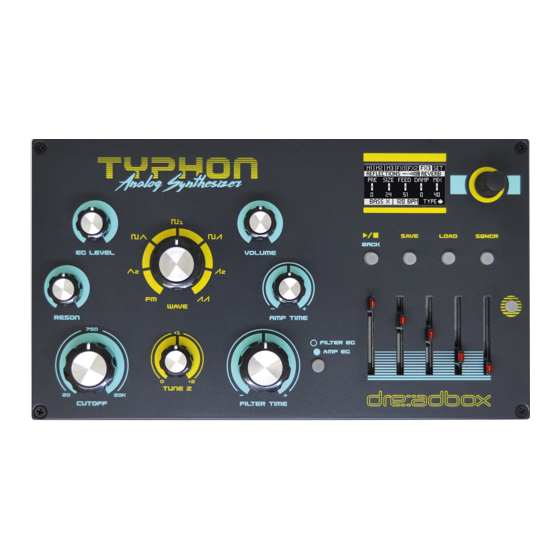
Table of Contents
Advertisement
Advertisement
Table of Contents

Summary of Contents for Dreadbox TYPHON
- Page 1 USER’S MANUAL...
-
Page 2: Table Of Contents
Table of Contents 1. Introduction 1.1 Key Features ..............................3 1.2 In the Box .................................3 1.3 Block diagram ..............................4 1.4 Quick start guide .............................5 2. Connections Powering considerations ............................6 3. Direct Analog Engine controls (left side) ....................7 4. Screen general manual ......................5. -
Page 3: Introduction
1.2 In the Box You will find a Typhon synthesizer and a USB cable. Please note that a USB mains adapter or power supply is not included, as nowadays we all usually have few lying around the house. Almost any USB adapter will work with the Typhon, but there are some power considerations, so please check the “Connections”... -
Page 4: Block Diagram
1.3 Block Diagram... -
Page 5: Quick Start Guide
Change page (on main) or selected values and scroll through menus. Sequencer play/stop or when in the menu “BACK” Push down to access the MENU. Push down also works as an ENTER. Amp ADSR time scale VCO 1 and VCO 2 setup Save your current sound Master volume Load a preset sound... -
Page 6: Connections
- When powering the Typhon from a computer, if you use a DAW to process the unit’s audio, a ground loop can be created, causing a noticeable hum. In that case, you should power the Typhon from a different power supply, and not from the same computer that you’re running the DAW on. -
Page 7: Direct Analog Engine Controls (Left Side)
3.Direct analog engine controls (left side) Typhon’s left side is dedicated to a set of 8 controls for quick and easy sound sculpting. Wave: This controls the waveform, amplitude, and routing of the two oscillators. With just a single knob, you can get the most interesting and useful combinations that these oscillators can offer. -
Page 8: Screen General Manual
“go back” action. 5. Presets The Typhon has a 256 patch storage locations, divided into 4 banks for easy access. On start-up, Typhon will load Bank A , preset 1. -
Page 9: Modulators
6. Modulators 6.1 General There are 3 available modulators, M1, M2, M3, that can be used on the Typhon. These 3 modulators can work at the same time and have multiple destinations for each modulator with different modulation amounts. Each modulator can be set to one of the following 4 modulation sources:... -
Page 10: Envelope Generator
6.5 Step sequencer Like the note sequencer, the step sequencer is synchronized to the Typhon’s BPM setting, but the two should not be confused as both provide different functions. While the note sequencer acts like a controller playing notes, the step sequencer is just another way to modulate parameters like the Filter Cutoff or the waveforms of the Oscillators. -
Page 11: The Sinevibes Effects
To change the pattern rate, hit SQNCR and rotate the encoder. For more info about BPM check “9. NOTE SEQUENCER” 7. The Sinevibes Effects Typhon is equipped with a set of powerful DSP effects developed by Sinevibes. For more info about Sinevibes, please visit www.sinevibes.com A high-quality, 32bit codec, running at 96kHz, is used to produce these effects, providing unparalleled sound quality. -
Page 12: Fx3: Reflections (Delay, Ping Pong, Reverb)
The controls are: DEPTH: Modulation amount SPD: Modulation speed WIDTH: When this is at 0, the effect is MONO. As you advance to 100 the left and right channels are split and a stereo effect is produced. At 100, both left and right channels have a 180 degree inverted modulation. FEED: Feedback of the effect MIX:... -
Page 13: Note Sequencer
9.1 Controls The note sequencer is a module that tells the Typhon what notes to play, when to play them, and how to play them. You can have from 1 to 32 steps in a sequence, covering a 6-octave range of notes. -
Page 14: Advanced Note Sequencer Tactics
STEP 5 and set -> LVL 20 10. Menu To access the MENU, from the main page, push the encoder. This will let you edit and manage some of the most useful parameters for controlling the Typhon. The list is: 1 Modulator Sync... -
Page 15: Mod Wheel
Here you can choose the maximum number of semitones the pitch will bend up or down. 10.8 Midi Channel Here you can set what midi channel the Typhon uses to receive midi data, as well as what midi channel the Typhon is transmitting on. Entering this setting you have 2 options: 1. -
Page 16: List Of Cc's
This is just a list of midi CCs for reference, which can’t be edited. 10.10 Calibration and hardware check To be updated 11. MIDI implementation Typhon can accept the following MIDI messages: - Note ON/OFF - Note Number - Aftertouch... -
Page 17: Specifications And Connections
60 Playing hours with 20,000mA portable power bank MIDI Din IN and OUT ¼ in Stereo Out ⅛ in Headphone Out ⅛ in Mono Audio In (for routing via Typhon FX) Dimensions: 23 x 13 x 6 cm Weight: 1kg JUNE 2020...








Need help?
Do you have a question about the TYPHON and is the answer not in the manual?
Questions and answers